
If we consider one of the integral bounds as variable, for example the upper bound, one definite integral corresponds to each value of this variable. That is to say the integral becomes a function F(x) of the upper bound:
| x | |
| F(x)= | ò f(t)dt |
| a |
A theorem, known as Theorem of Torricelli, demonstrates that, if the function to integrate f(t) is continuous, exists the derivative of the integral functon F(x) in the point x, and it equals the value that the function to integrate reaches in the same point. The result is that F '(x)=f(x). That is to say F(x) is a primitive of f(x). In the beside picture the function F(x) is that particular primitive that passes through the point of abscissa x=a.